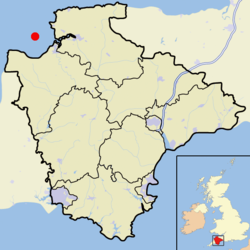Bideford Bay
| Bideford Bay | |
|---|---|
 |
|

View over Bideford Bay, looking north-eastwards from Clovelly towards Baggy Point
|
|
| Coordinates | 51°04′N 4°20′W / 51.067°N 4.333°WCoordinates: 51°04′N 4°20′W / 51.067°N 4.333°W |
Bideford Bay, also known as Barnstaple Bay and often shown on maps as Barnstaple or Bideford Bay, is a large area of water on the northwest coast of Devon in South West England, at the southwestern end of the Bristol Channel where it joins the Celtic Sea. The bay extends from Hartland Point in the southwest to Morte Point in the northeast, a distance of 14 miles (23 km), and is partly sheltered by the island of Lundy, 12 miles (19 km) offshore. It takes its alternative names from the towns of Bideford and Barnstaple, located respectively on the rivers Torridge and Taw which flow into the bay. The alternative spelling Barnstable Bay, in use long after that spelling became obsolete for the town, is also sometimes seen.
The north-facing coastline east of Hartland Point is backed by steep wooded or rocky cliffs with no natural harbours; this section is sparsely populated. The small former fishing village of Clovelly is a popular tourist destination, with a man-made harbour. Further east is the village of Westward Ho!, where there is a clearly defined raised beach platform, cut well above the level of the present beach by wave action at times of high sea levels. There is a submerged forest with peat deposits at the southern end of Westward Ho! Beach, providing evidence of sea level rise which swamped the coastal forest about 6,000 years ago.
North of Westward Ho! the coastline changes to one of extensive sandy beaches backed by sand dune systems. The combined estuary of the rivers Taw and Torridge emerges into the bay between the dune systems of Northam Burrows and Braunton Burrows. The Northam Burrows area is managed as a country park, and comprises a grassy coastal plain with a shingle ridge and spit formed by a process of longshore drift. Braunton Burrows is one of the largest sand dune systems in Britain, at over 3 miles (5 km) long and 1 mile (2 km) wide, and backs the long wide sandy beach of Saunton Sands. The dunes are of international importance for their wildlife, including a number of rarities, and form the core of a Biosphere Reserve.
...
Wikipedia
